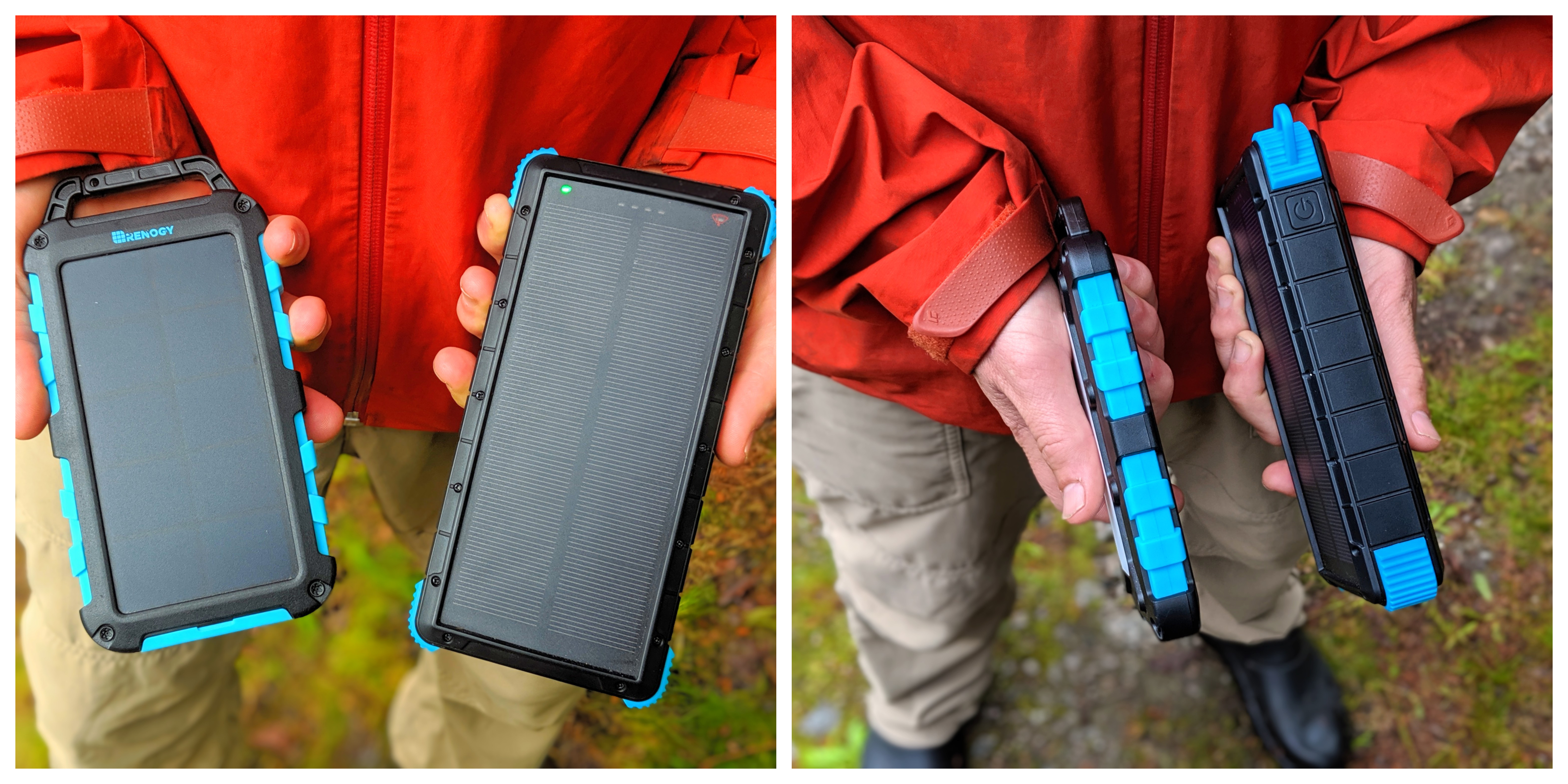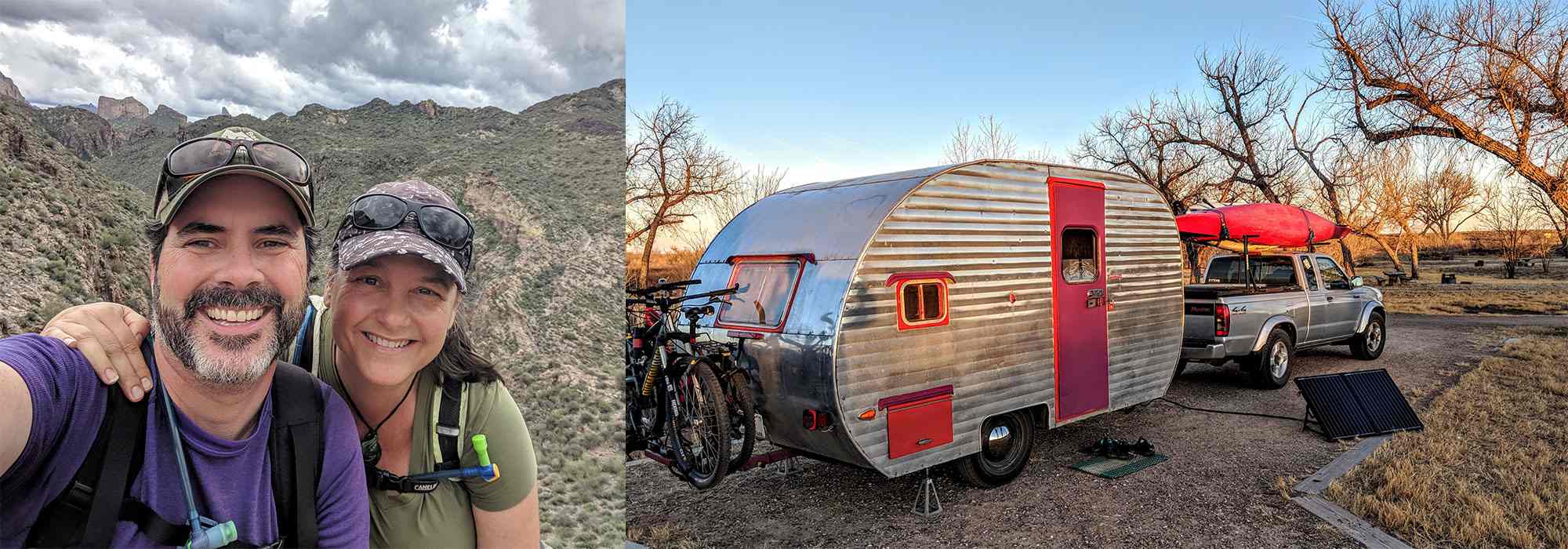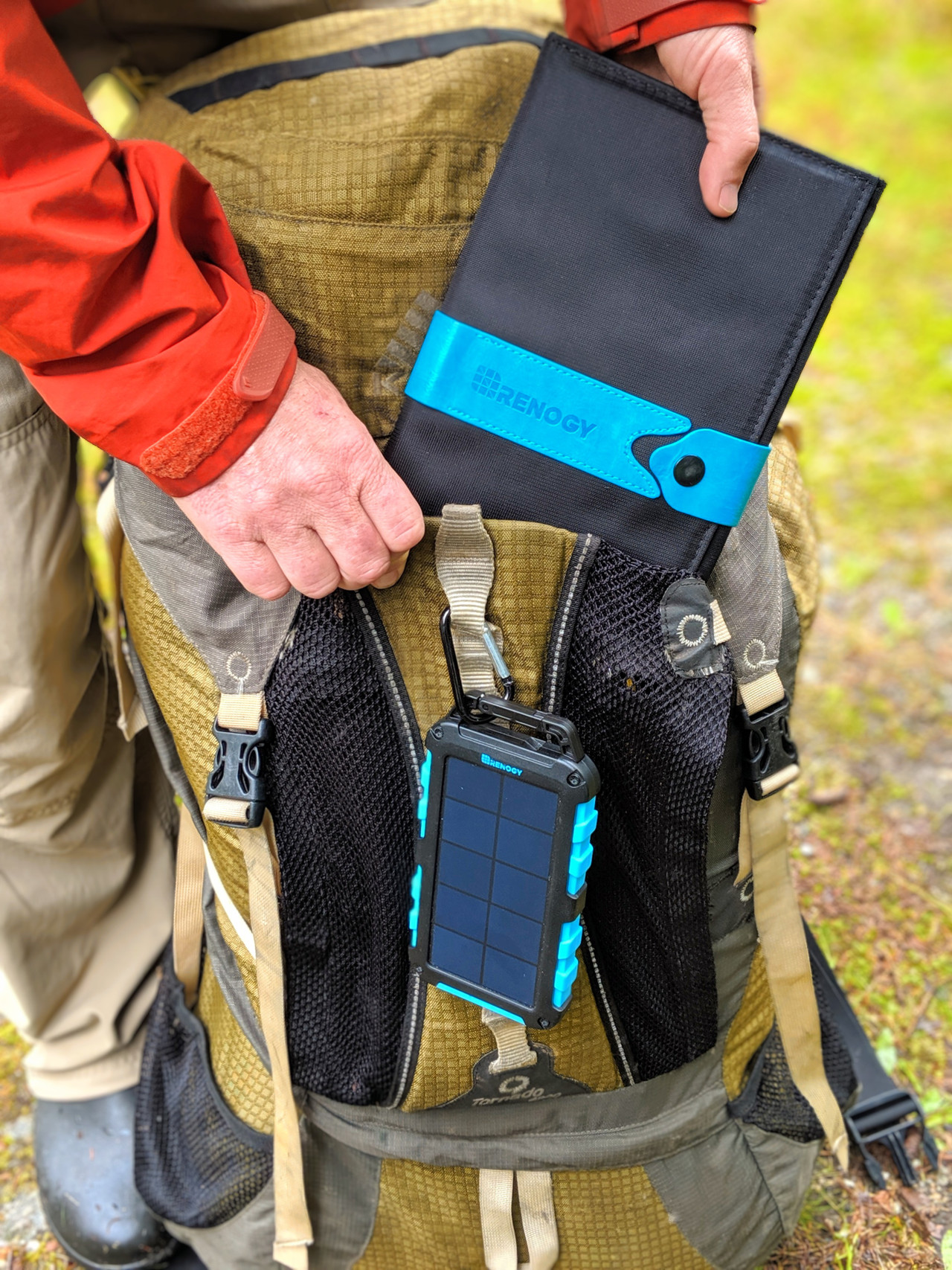Backpacking with Solar: Portable Power Banks & Panels
In our tiny, off-grid, rolling home, our basic solar power system is more than adequate to keep all of our personal electronics, laptops, and camera batteries charged up. But what about adventures that take us farther away from our comfy 72-square feet? When we choose to get into the backcountry on foot, by paddle, or on two-wheels, we usually take our smartphone, even though posting selfies is almost the last thing on our mind. Getting away from areas with full LTE signals is all part of the point of getting out in the first place. But this lightweight piece of modern tech (Google Pixel 2 XL) simply takes amazing photos and videos. So good sometimes, that I question the need for (and the weight of) our DSLR camera. Just as I protest, Shari takes an amazing wildlife shot with her telephoto lens, or a captivating landscape with her wide angle and we’re back enthusiastically lugging the extra weight. All that gear requires a little backup in the power department. As freelancers who rely on getting quality images to go along with a quality story, leaving the technology behind isn’t always an option.

In 2016 we spent 18 days under human power, crossing the North Cascades ecosystem by bike, foot and paddle. We kept everything topped off with just one simple 20 Watt portable panel, no back up battery. However, we had to be strategic about our breaks, and get out the solar panel at each stop. We wished we’d had a little more flexibility.
With the combination of a portable panel and power bank, you can choose a charging time that fits into your schedule (and fickle weather) rather than the other way around. These handy chargers are nothing new, and many now come with integrated solar panels. This makes it seem like it is all you need – plug in, find sun, and go. The ads all over social media are a little misleading, because the integrated panels are so small it makes them impractical to use by themselves as they could take 30-60 hours in the full sun to charge up their own battery. The optimal solar charging situation is to store energy into the power bank by connecting it to a 20-30W external panel and then use that stored energy to charge your appliances.
Portable Power Banks: What’s in an Amp?
Getting your head around the ratings of an external power source can be confusing, making you wish you got a degree in Physics or Engineering. Batteries are typically rated in terms of Amp hours (Ah) and Watt hours (Wh), which gives you an understanding of the work the battery can do and for how long before needing a recharge. Small, portable batteries are rated in Wh and milliamp hours (mAh). For those of us who are math challenged, 1000 mAh = 1 Ah, so 24,000 mAh = 24 Ah. This is all nice to know, but what we really want to know, of course, is how fast will it charge our phone, tablet, etc. and how many charges can we get. The answer depends on a number of factors, including the battery size of your phone, the power output of the battery, and even the type of cord you use to charge.
E. Power Bank 10,000 mAh / 37 Wh
This lightweight (10.1 oz) power bank comes in a rugged case with some cool features including a rubber outlet cover, LED flood light (which is surprisingly bright), and an integrated clip to attach it to the outside of a backpack. The 1.21 W integrated solar panel would take approximately 30.5 hours of full sun, but it does help keep it topped up in between charges. It can be recharged by plugging it into any USB outlet or by connecting it to an external solar panel. It claims to charge a standard smartphone between 2-3 times.

E. Power Bank 24,000 mAh / 88.8 Wh
This larger battery has 2.4 times the capacity of its smaller cousin, and weighs almost twice as much, at 1.25 lbs. It also has a rugged case, rubber outlet cover, and LED flashlight with 3 settings. The integrated panel is a bit stronger at 1.5 W, but still will take approximately 60 hours to fully charge the battery. Again, these integrated panels are good for emergency power outages and keeping the battery charged while it’s not being used. It claims between 5-8 smart phone charges. It offers multiple charging ports, including a USB-C which can greatly increase the charging speed of whatever device you need to charge.
Both of these power banks are slightly larger than the palm of your hand, making them easy to fit into a backpack, boat bag, bike cart, dry bag, or even carry-on luggage for a long plane ride. You may also consider leaving one on the dashboard of your car, so it’s always charged when you need it.

Portable Solar Panels
These small and easy to use solar panels are a little less complex than their portable battery counterparts. Rated in watts, the panels indicate their maximum output when set up in the full sunlight. Both models fold up easily and secure with a snap, are equipped with a built-in voltage controller, and have at least 2 USB ports.
E. Flex Portable Solar Panel 21 Watt
Folds out easily in 3 sections, has a built-in kickstand, offers 2 USB charging ports, and weighs less than 1.2 lbs. Dimensions are 11.4” x 6.2”, making it slightly smaller than a sheet of standard notebook paper.
E. Flex Portable Solar Panel 30 Watt
Folds out into 4 sections, has 2 built-in kickstands, offers 3 USB charging ports, and weighs around 1.6 lbs. Folded dimensions are 11.8” x 6.3”, and just a bit thicker than the 21W panel.

Both of these panels are small enough to easily fit into a daypack, boat bag, bike cart, dry bag, or even carry-on luggage. They are absolutely perfect for bringing along on a longer trip when a reliable power source to charge up your small electronics might be in doubt!

Performance
We spent 3 days and 2 nights backpacking on the Bold Coast of Maine with some of Renogy’s latest portable products. We opted to take the lightest weight configuration of the
10,000 mAh E. Power Bank and 21W Portable Solar Panel, which only increased my pack weight by about 2 pounds. Definitely, not bad for what it was able to do for us while out on the trail!
We started the trip with a fully charged smartphone and camera batteries and our power bank at 75%. After our first day on the trail, the phone was nearly dead from shooting numerous pictures and video. Using the E. Power bank, we plugged it in overnight. By morning, the phone was fully charged and the power bank was down to 25%. During a leisurely breakfast on the sunny cobblestone beach, we used the portable solar panel to charge up the power bank.

Within 2 hours of mostly sunny skies mixed with passing clouds, the battery indicator on the power bank showed a 75% charge. Later in the day, the phone conked out again, but we were able to charge it back up to 100% using the power bank in about 3.5 hours while hiking along the coast. After charging the phone, the power bank had less than 25% remaining, so we topped off our DSLR camera batteries overnight. It was a good thing, too, because the fog rolled in the following day, with no opportunity for solar gain.

Lightweight: Weighing in at just about 2 pounds, this configuration seemed to be the best option for the short time we were out in the field and the expected weather.
Durability: These products are made for some banging around in or on backpacks. The power bank has a rugged case to prevent breakage and can withstand some wet, foggy weather (though it is not designed to be left out in the rain or submerged in water). The portable panel is made from rugged water-resistant material, has some light padding, and is flexible enough to bend a bit, which is inevitable if you are carrying multiple things in a backpack.

Other Cool Features: We used the flood light on the back of the power bank to light up our tent, which happened to make for an incredible foreground against a full moon rising over the Gulf of Maine. Also, the built-in clip at the top allows you to easily hang the unit on the outside of a backpack and it also comes with additional carabiners.

Drawbacks: There are just 4 battery status lights on the power bank, rather than an LCD display or “thermometer” – making it a bit difficult to know exactly how much charge is available. For instance, 1 light equals 1% to 25% battery charge, 2 lights equal 26% to 50% charge, and so forth. Thus, there is a large range between the indicator light levels. You really have to stay on top of the battery status or you might find yourself out of juice before you know it.
Overall: This set-up was great for a short trip where we were carrying the weight on our back, especially since we anticipated some sun in the forecast for recharging. Had this been a longer trip, or with less hope for sun, we might have opted for the larger, 24,000 mAh power bank. These are a nice investment for our work and adventures we get up to, and hope to use these products for many years to come. We’ll check back in for a long-term performance review in 2020.

Learn more about Shari & Hutch’s solar powered adventures on their website and join them on the road via social media at Facebook, Instagram, and YouTube!








